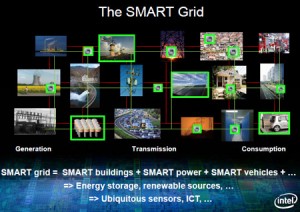Gentiana Spahiu
February 14th, 2011
What is Demand Response?
“Demand Response entails customers changing their normal consumption patterns in response to changes in the price of energy over time or to incentive payments designed to induce lower electricity use when prices are high or system reliability is in jeopardy.” (1)
Considering this ‘official’ definition of Demand Response (DR), we can safely assume that DR is directly related to price changes in the cost of energy and how the consumers respond to it. DR  encompasses numerous programs created to maintain energy consumption in check especially during peak-hours or the “FERC (Federal Energy Regulatory Commission) definition of DR covers the complete range of load-shape objectives and customer objectives, including strategic conservation, time-based rates, peak-load reduction, as well as customer management of energy bills.” (2)
encompasses numerous programs created to maintain energy consumption in check especially during peak-hours or the “FERC (Federal Energy Regulatory Commission) definition of DR covers the complete range of load-shape objectives and customer objectives, including strategic conservation, time-based rates, peak-load reduction, as well as customer management of energy bills.” (2)
To be in balance, the supply-demand curve needs that at any point when the demand increases the supply mechanism should provide a matching amount of energy. With a price-volatile energy market, at times such excess amounts could be very expensive or even unavailable. Hence the role of Demand Response in such circumstances is crucial because it adds reliability and more control over the prices.
There are two types of Demand Response:
1- Emergency Demand Response
In emergency cases like unusual cold or hot weather, when the amount needed to be supplied to the increased demand is not available, then the electric utility providers call on their emergency programs. This translates into minimal usage of energy from commercial and industrial consumers, levels of which are previously defined. Such measures prevent a considerable power outage which could have cost much more than merely reducing the electric usage to a minimal functioning level, consequently making the electricity more reliable and cheaper.(3)
from commercial and industrial consumers, levels of which are previously defined. Such measures prevent a considerable power outage which could have cost much more than merely reducing the electric usage to a minimal functioning level, consequently making the electricity more reliable and cheaper.(3)
2- Economic Demand Response
The programs in this category help the utility providers help consumers to reduce costs. In a nut shell, even though we, the customers, generally pay a flat rate for kWh, the utility providers pay a fluctuating price throughout the year. The cost that is transferred to consumers is the average price that providers pay, therefore placing the amount of energy consumed directly related to the cost per unit that we use. Economic Demand Response runs programs that provide some incentives to the consumers if they use energy during off-peak hours, or by placing time-based pricing (higher cost rates) to the ones that use it during peak times. (3)
DR programs allow for users to be more aware of their energy consumption and the real-time prices, therefore leading to more educated decisions in how, when, and at what cost and time is more feasible to use electricity.
http://www.youtube.com/watch?v=yGk13U_kgGM&feature=autoplay&list=QL&index=1&playnext=2
What makes the communication possible between the providers and the consumers of electricity are the Smart Application Grids. This technology provides products and services that facilitate the monitoring and the dynamic control of electricity usage. (4) New and better data are collected through such communication networks from which valuable information is generated into improving the distribution system of electricity as well as its consumption rate. Another positive aspect of the Smart Grids is that it has the potential to accommodate renewable energy sources, which perfectly fits with the energy-efficient agenda that the world is pursuing.
Limitations….
A downside of Demand Response is the fact by being just a response; DR has a short life-span and does not treat the issues of the energy consumption from the core. DR routinely breaks certain patterns of electricity usage within the consumers for a limited amount of time, but does not change them. Therefore the benefits derived just by DR programs are generally short-lived, but nonetheless crucial in the master plan of creating an energy-efficient world.
A solution to the above limitation is through pairing up Demand Response with the Energy Efficiency platform. Such coalition would indeed boost the awareness on electricity cost and its effect on the social budget as it would facilitate the accomplishment of the National
Action Plan for Energy Efficiency’s Vision to achieve all cost-effective energy efficiency by 2025.(1)
Interested in knowing what affects the cost of electricity? Measure it….
Wattage x Hours used ÷ 1000 x Price per kWh = COST OF ELECTRICITY
1- National Action Plan for Energy Efficiency (2010). Coordination of Energy Efficiency and Demand Response. Prepared by Charles Goldman (Lawrence Berkeley National Laboratory), Michael Reid (E Source), Roger Levy, and Alison Silverstein. www.epa.gov/eeactionplan
2- ELECTRICLIGHT&POWER, What is Demand Response? By Dr. Steve Isser, Good Company Associates, June 2009
3- http://www.energydsm.com/demand-response/
4- Demand Response and Smart Grid Coalition
http://www.drsgcoalition.org/resources/factsheets/Demand_Response_and_Energy_Efficiency.pdf

Very informative and interesting. Great job!